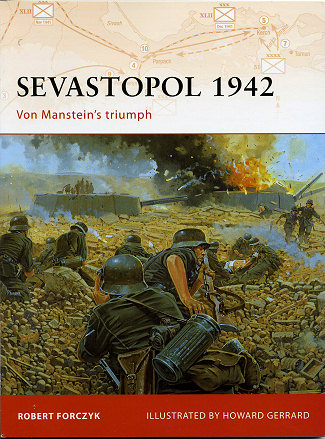 Number
189 in the 'Campaign' series covers the German advances into the Crimea during
1942 and the subsequent battles to capture the major city in the are,
Sevastopol. This campaign could rightly be considered one of the most artillery
intensive battles of the war. Not only did the Soviets have large, turreted gun
emplacements (originally designed for coastal defense, but able to be swung
around landward), but it is here that the huge siege guns, the Karl mortars and
Dora rail gun, were used, though not quite with the effect that was expected.
Number
189 in the 'Campaign' series covers the German advances into the Crimea during
1942 and the subsequent battles to capture the major city in the are,
Sevastopol. This campaign could rightly be considered one of the most artillery
intensive battles of the war. Not only did the Soviets have large, turreted gun
emplacements (originally designed for coastal defense, but able to be swung
around landward), but it is here that the huge siege guns, the Karl mortars and
Dora rail gun, were used, though not quite with the effect that was expected.
Sevastopol had to be overtaken if the Germans were ever to
reach the oil fields of the Caucus mountains and Von Manstein was sure he could
take it. However, he had a couple of problems. One was that he had what he had
and there would be no German troop reinforcements so he had to be cautious about
their use. Secondly, the Luftwaffe was spread very thinly everywhere and no more
so as in Russia, where units were frequently called upon to stop operations in
one area and move several hundred miles to another location to help out in
battle.
A considerable portion of Von Manstein's success was because
the Luftwaffe was there to maintain air superiority while his troops moved. Once
that was gone, the way became much more difficult.
Then there were the Russians, who were fighting for their
homeland. However, the actions of most Soviet commanders were based on set,
pre-war plans and field commanders did not enjoy as much freedom of thought as
did the Germans. This resulted in a rather high number of troops that were
killed/wounded/captured. In the end, the Soviets were down to an 'every man for
himself' scenario with leaders scampering away at the earliest opportunity.
Robert Forczyk covers the preparations, and all the various
battles in and around Sevastopol in a manner that is both interesting and easy
to read. This is all superbly illustrated by Howard Gerrard and with an
excellent choice of maps, diagrams, and period photographs to lead us through
what could have been a confusing set of operations.
It is an excellent book on a part of WWII that rarely gets
any sort of press. One that I know you will enjoy reading as much as I did.
February 2008.
For more on the complete line of Osprey books,
visit www.ospreypublishing.com. In the US, it is
Osprey Direct at 44-02 23rd St, Suite 219, Long Island City, NY 11101., where you can
get a catalogue of available books.
If you would like your product reviewed fairly and quickly, please contact
me or see other details in the Note to
Contributors.
 Number
189 in the 'Campaign' series covers the German advances into the Crimea during
1942 and the subsequent battles to capture the major city in the are,
Sevastopol. This campaign could rightly be considered one of the most artillery
intensive battles of the war. Not only did the Soviets have large, turreted gun
emplacements (originally designed for coastal defense, but able to be swung
around landward), but it is here that the huge siege guns, the Karl mortars and
Dora rail gun, were used, though not quite with the effect that was expected.
Number
189 in the 'Campaign' series covers the German advances into the Crimea during
1942 and the subsequent battles to capture the major city in the are,
Sevastopol. This campaign could rightly be considered one of the most artillery
intensive battles of the war. Not only did the Soviets have large, turreted gun
emplacements (originally designed for coastal defense, but able to be swung
around landward), but it is here that the huge siege guns, the Karl mortars and
Dora rail gun, were used, though not quite with the effect that was expected.